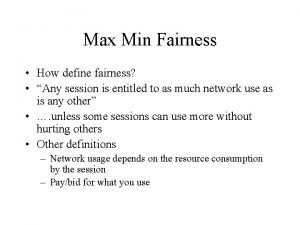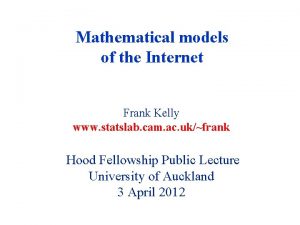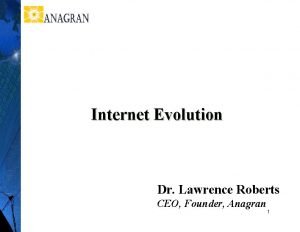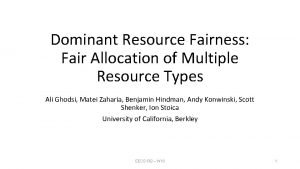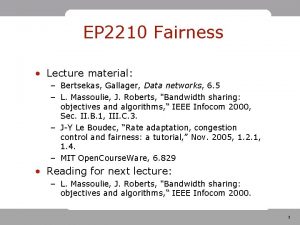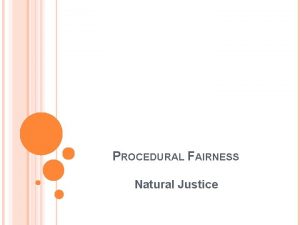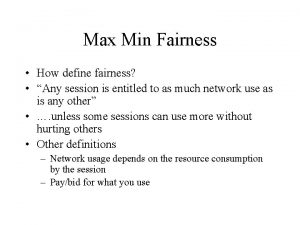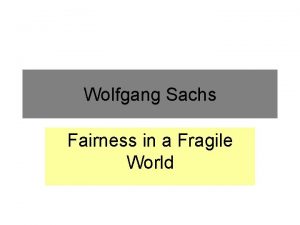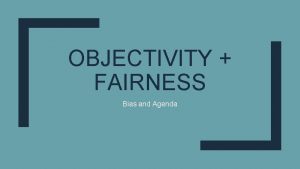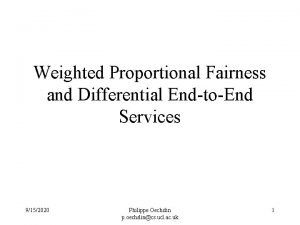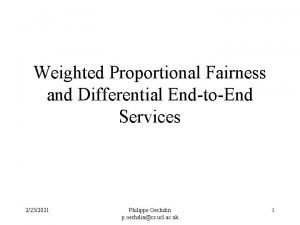Mul TFRC TFRC with weighted fairness draftwelzlmultfrc00 Michael












- Slides: 12

Mul. TFRC: TFRC with weighted fairness draft-welzl-multfrc-00 Michael Welzl, Dragana Damjanovic 75 th IETF Meeting Stockholm, Sweden 29 July 2009

Motivation • TCP-friendliness has been criticized a lot – ICCRG has a design team now – Non-standard TCP variants are used • Multimedia applications should use a reasonable (ideally IETF-approved) congestion control mechanism – Need to make this attractive • Our suggestion: N-TCP-friendliness – Multiple TCPs do a better job; multiple flows are already used in practice for this reason – We already know that they don’t cause much harm

What is Mul. TFRC? • Like Mul. TCP: a protocol that is N-TCP-friendly – – Larger range of possible values for N than for others, e. g. Mul. TCP and CP – Yields flexible weighted fairness (e. g. priorities between users, or between flows of a single user) • Based on TFRC – Easy to implement as an extension of TFRC code – Change the equation + measure “real” packet loss

The new equation • Dragana Damjanovic, Michael Welzl, Miklos Telek, Werner Heiss: "Extending the TCP Steady-State Throughput Equation for Parallel TCP Flows", University of Innsbruck, Institute of Computer Science, DPS NSG Technical Report 2, August 2008. – available from http: //heim. ifi. uio. no/michawe/research/projects/multfrc/index. html – also SIGCOMM‘ 07 poster, 2 -page text available from the same page • Most readable in algorithm form n - number of flows b – no. of packets ACKed by one ACK RTT - round-trip time T - initial period of time (in TO phase) after which the sender retransmits unacknowledged packets – pe - loss event probability of the cumulative flow – pr - probability that a packet is lost – –

Equation validation (ns-2 simulations; we also did real-life tests)

Some evaluation results More: Dragana Damjanovic, Michael Welzl: "Mul. TFRC: Providing Weighted Fairness for Multimedia Applications (and others too!)", accepted for publication in ACM Computer Communication Review, 2009. Drop. Tail RED

Real-life tests (local testbed, bottleneck link 32 Mbit/s)

Zooming into the 0 ≤ N ≤ 2 range Bottleneck link capacity 4 Mbit/s

Responsiveness and smoothness mul. TFRC n=4; 4 TCP; 4 TFRC

Reasons to use Mul. TFRC • N-TCP-friendly congestion control attractive – better performance for N>1 • Why is this better than multiple real TFRCs? – More reactive and smoother – Tunable congestion control with fine granularity and large range for N, including 0<N<1 – Less overhead (connection setup, teardown, state in end systems, . . ) – No need to split data across multiple connections

How should it be used? • Mul. TFRC also makes sense for reliable transfers (e. g. files) – But these apps don’t need a smoother rate, and TFRC is generally less reactive than TCP. . . • Setting N – Only at the beginning (otherwise: implications unknown) – Our suggestion: limited to 6 • • • N TCPs alone: roughly up to 100 -100/(1+3 N) % bottleneck saturation 1 flow 75%, 3 flows, 90%, 6 flows 95% Gain decreases as N grows; from 1=>2 14. 3 %, but less than 1% beyond 6 6 TCPs from one host not uncommon 6 will let users saturate their bottleneck (typically access link) better than one TFRC or TCP, larger numbers will still make the flow more aggressive when competing with others

Thank you


